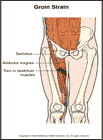
Groin Strain
What is a groin strain?
A strain is a stretch or tear of a muscle or tendon. People commonly call such an injury a "pulled" muscle. The muscles in your groin help bring your legs together. There are two muscles that may commonly get injured in a groin strain: the adductor magnus (the large muscle running down the inner side of the thigh) and the sartorius (a thinner muscle that starts on the outside of your hip, crosses your thigh and attaches near the inside of the knee).
How does it occur?
A groin strain most commonly occurs when you are running or jumping or when there is a forced push-off or cut.
What are the symptoms?
You will have pain or tenderness along the inner side of your thigh or in the groin area. You will have pain when you bring your legs together. You may have pain when lifting your knee up.
How is it diagnosed?
Your health care provider will take note of your symptoms and will examine your thigh and hip.
How is it treated?
Treatment may include:
- applying ice to the strained muscle for 20 to 30 minutes every 3 to 4 hours for 2 or 3 days or until the pain goes away
- taking an anti-inflammatory medication prescribed by your health care provider
- wearing a supportive bandage called a thigh wrap or taping your thigh or groin
- doing the rehabilitation exercises you are given.
While you are recovering from your injury, you will need to change your sport or activity to one that does not make your condition worse. For example, you may need to swim instead of run.
When can I return to my sport or activity?
The goal of rehabilitation is to return you to your sport or activity as soon as is safely possible. If you return too soon you may worsen your injury, which could lead to permanent damage. Everyone recovers from injury at a different rate. Return to your sport or activity will be determined by how soon your groin area recovers, not by how many days or weeks it has been since your injury occurred. In general, the longer you have symptoms before you start treatment, the longer it will take to get better.
You may safely return to your sport or activity when, starting from the top of the list and progressing to the end, each of the following is true:
- You have full range of motion in the injured leg compared to the uninjured leg.
- You have full strength of the injured leg compared to the uninjured leg.
- You can jog straight ahead without pain or limping.
- You can sprint straight ahead without pain or limping.
- You can do 45-degree cuts, first at half-speed, then at full-speed.
- You can do 20-yard figures-of-eight, first at half-speed, then at full-speed.
- You can do 90-degree cuts, first at half-speed, then at full-speed.
- You can do 10-yard figures-of-eight, first at half-speed, then at full-speed.
- You can jump on both legs without pain and you can jump on the injured leg without pain.
How can I prevent a groin strain?
A groin strain is best prevented by warming up properly and doing groin muscle stretching exercises prior to your activities. This is especially important in activities such as sprinting or jumping.

